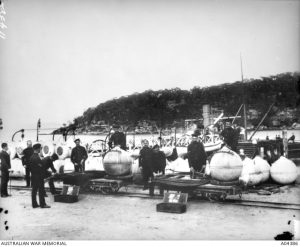- Author
- Haken, J.K., Dr
- Subjects
- History - general, Naval technology
- Tags
-
- RAN Ships
- None noted.
- Publication
- December 2017 edition of the Naval Historical Review (all rights reserved)
Dr J. K. Haken
Mines and submarine mining are always associated with the Navy, but internationally and locally the early development was with the Army Engineers.
Mines and underwater explosives were developed by the ancient Chinese, but in 1812 Paul Shilling, a Russian engineer, exploded an underwater mine electrically. This formed the basis of submarine mining, where mines protect harbours against attack. British Army staff including Engineers filled many roles in the Colonies and more than half a century passed before local troops eventuated. Victoria was the first of the Australian Colonies to raise an Engineer Corps1. Rules and Regulations for the Victorian Volunteer Engineers were signed on 9 March 1861 and a Torpedo and Signalling Corps was formed in 1870. The volunteer section was disbanded in July 1882 but the permanent section remained, known as the Permanent Section, Torpedo Corps and later as the Permanent Section, Submarine Miners. In 1886 the Torpedo Corps was renamed the Submarine Miners and was combined with the Engineers2.
In New South Wales Engineers were formed on 28 December 18703. The Torpedo and Signalling Corps was formed in 1873 and was the sixth Company of the NSW Naval Brigade commanded by E.C. Cracknell who transferred to the NSW Military Forces on 8 October 18774. In 1882 part of the Torpedo and Signalling Corps was re-designated as NSW Submarine Miners and became part of the Engineer Corps. At Federation the Submarine Miners were No 3 Company NSW Engineer Corps5. The greatest military disaster that had been experienced at the time occurred on 3 April 1891, when at an official demonstration a fatal explosion resulted in the deaths of four men. A mistake by an experienced RE NCO (on loan to the Colony) resulted in the destruction of the rowing craft and of nine other boats tethered alongside.

In 1877 a company of Engineers formed in Queensland and disbanded in 1893 before reforming in 1899 as the Brisbane Company of Submarine Miners5. In Victoria the Company was located at Swan Island, in New South Wales initially at Berry’s Bay and subsequently at Chowder Bay. Chowder Bay remains a military site. Both Swan Island and Chowder Bay are heritage listed. After Federation, the Australian Corps of Engineers was formed on 1 July 19026and the Submarine Miners consisted of No 1 Company Submarine Miners formerly No 3 Company NSW Corps of Engineers7, No 2 Company formed from Field and Submarine Companies, Victorian Engineers7,8and No 3 Company Submarine Miners formerly Brisbane Company of Submarine Miners7. No 3 Company was short lived, disbanding in 19099.
In 191210the Engineer Forces were reorganised and many amalgamations occurred. 37 Engineers (Submarine Mining Company) was formed from No 1 Submarine Mining Company while 38 Engineers (Submarine Mining Company) evolved from No 2 Submarine Mining Company. 37 Engineers (Submarine Mining Company) became 37 Engineers (Fortress Company). With re-organisation on 1 July 1913 the name was changed to 37 Fortress Company Engineers11. The Company was assigned to fixed defence on 31 March 192112. The 38 Engineer (Submarine Mining) Company became 38 Fortress Company Engineers on 1 July 191311, it also being assigned to fixed defence in 192112. Lieut. Gen. Sir Cyril Brudenell White, the Chief of the General Staff, decided that the submarine mining technique was obsolete13and subsequently all mining activities were transferred to the Royal Australian Navy in August 192214.
References
- Royal Australian Engineers Association of Western Australia.
- G. R. Vazenry, Military Forces of Victoria 1854-1967, Self-published Albert Park Barracks Melbourne c1968. Ch 6.
- NSW Government Gazette 322 2897, 30 December 1870.
- J. K. Haken, Lineage and Officers of the New South Wales Naval Forces 1863-1902The Naval Historical Society of Australia, Monograph 199, September 2003.
- G.R. Vazenry, Reorganisation. Self-published Albert Park Barracks Melbourne c1969, p 339.
- Commonwealth of Australia Gazette 58 606, 13 December 1902.
- The Military Forces Commonwealth of Australia List 1 February1904.
- Burton, H. A. An Account of the Corps from its Foundation to1932.Manuscript 1932, p 9.
- NAC File1924/18 Melb. Perm. Ser. 84/1 CMNcN.
- Commonwealth of Australia Gazette 51 1374 3 August1912, MO 428/1912.
- MO 403/11913.
- MO 95/19212.
- T. Hutchinson, The Miners of Chowder Bay, Army Newspaper, reproduced on line.
- P. J. Greville, The Royal Australian Engineers 1945-1972, Paving the Way.Volume 4, Corps Committee Royal Australian Engineers 2002, p 8.




